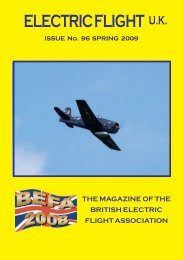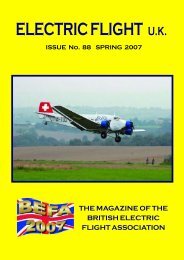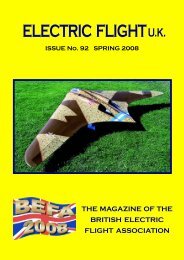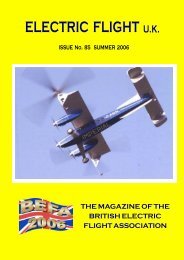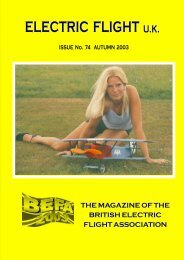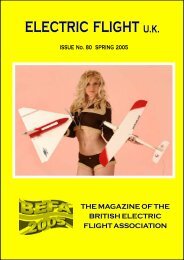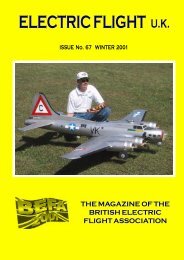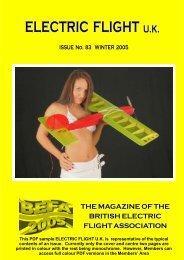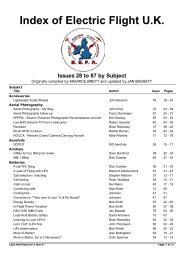ELECTRIC FLIGHT U.K. - British Electric Flight Association
ELECTRIC FLIGHT U.K. - British Electric Flight Association
ELECTRIC FLIGHT U.K. - British Electric Flight Association
Create successful ePaper yourself
Turn your PDF publications into a flip-book with our unique Google optimized e-Paper software.
A Tale of Two Twins<br />
by John Stennard<br />
Say 'twins' and one's thoughts usually move to 'twin engines' or 'twin wings' and<br />
not to 'twin rotors'. However I've recently been enjoying flying two very different<br />
but equally impressive electric 'twin-rotor' helicopters<br />
The most exciting of the two has got to be the MS CH-46 Sea Knight but this is<br />
closely followed by the diminutive but hugely enjoyable Hirobo XRB Lama. Both<br />
in different ways reflect just how far micro electric helicopters have come in very<br />
short time. The first really successful commercial design, the Piccolo from Ikarus<br />
started an interest in these small machines that has grown to quite amazing<br />
proportions. There are literally dozens of relatively easy to fly micro helicopters<br />
available and every time I test a new one it seems to be better than the last.<br />
Our regular winter indoor sessions have shown just how popular these helicopters<br />
have become and six flying at a time in just a one basketball sized gym has not<br />
been unusual.<br />
I am regularly involved in giving talks to model clubs on the subject of indoor RC<br />
and sometimes in a cramped, pub 'back-room', an electric helicopter is all that I<br />
can demonstrate, although this is changing now that so many model aircraft can<br />
also be easily hovered.<br />
I am always looking for something different for indoor flying and the CH-46 is<br />
certainly that. This twin rotor helicopter is a fine example of applying the latest<br />
technology to a very difficult concept. Basically this helicopter would be un-flyable<br />
without the assistance of the two gyros linked to a microprocessor. While I'm not<br />
going to look in detail at this helicopter a short overview will explain how it works<br />
and why it is both very<br />
fascinating and satisfying to<br />
fly.<br />
Starting with the mechanics<br />
the rotor heads are two<br />
collective heads as used on<br />
the MS Hornet helicopter.<br />
These are mounted at either<br />
end of an aluminium and<br />
glass-board chassis. Each<br />
rotor head uses 3 servos that<br />
plug directly into the<br />
microprocessor unit and leads<br />
from the processor plug into<br />
the receiver.<br />
The forward gearbox and double-ended Twister motor<br />
48 E.F.-U.K.



